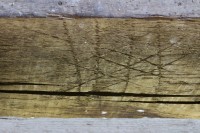 Building archaeologists from the Museum of London Archaeology (MOLA) surveying Knole House, the stately Kent seat of the Sackville family, have discovered protective witchmarks carved on the beams of a room built to house King James I. The marks, checkerboard lines known as demon traps because the evil ones would follow the lines and get caught in them, and interlocking Vs that stand for Virgo Virginum and invoke the protection of the Virgin Mary, were carved by craftsmen in the beams and joists under the floor and on the oak fireplace surrounds in the Upper King’s Room.
Building archaeologists from the Museum of London Archaeology (MOLA) surveying Knole House, the stately Kent seat of the Sackville family, have discovered protective witchmarks carved on the beams of a room built to house King James I. The marks, checkerboard lines known as demon traps because the evil ones would follow the lines and get caught in them, and interlocking Vs that stand for Virgo Virginum and invoke the protection of the Virgin Mary, were carved by craftsmen in the beams and joists under the floor and on the oak fireplace surrounds in the Upper King’s Room.
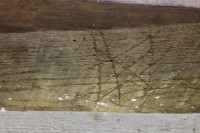 Thanks to tree-ring dating, we know exactly when the marks were carved. The oak timber was felled in the winter of 1605-06 and was used while it was still green, which means the beams were in place by the summer of 1606 at the latest. Guy Fawkes and seven other conspirators in the plot to blow up the House of Lords during the Opening of Parliament on November 5th, 1605, were hanged, drawn and quartered on January 31st, 1606. Fawkes had been arrested tending to 36 barrels of powder in the undercroft of the House of Lords just 12 hours before the explosion was set to go off, so the King and the entire ruling hierarchy of Britain came very close to annhilation and the memory of it was very fresh when the work was done at Knole.
Thanks to tree-ring dating, we know exactly when the marks were carved. The oak timber was felled in the winter of 1605-06 and was used while it was still green, which means the beams were in place by the summer of 1606 at the latest. Guy Fawkes and seven other conspirators in the plot to blow up the House of Lords during the Opening of Parliament on November 5th, 1605, were hanged, drawn and quartered on January 31st, 1606. Fawkes had been arrested tending to 36 barrels of powder in the undercroft of the House of Lords just 12 hours before the explosion was set to go off, so the King and the entire ruling hierarchy of Britain came very close to annhilation and the memory of it was very fresh when the work was done at Knole.
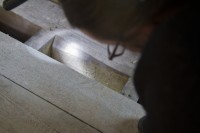 The discovery answers a long-debated question about witchmarks. Some historians contend that they are carpenters’ marks used for practical purposes as installation guides, but the Knole timbers have both standard carpenters’ marks and witchmarks. Add to that the remodeling in anticipation of the King’s visit and the precise date in the looming shadow of the Gunpowder Plot, and the Knole marks are strong evidence that they were intended to play a supernatural protective role.
The discovery answers a long-debated question about witchmarks. Some historians contend that they are carpenters’ marks used for practical purposes as installation guides, but the Knole timbers have both standard carpenters’ marks and witchmarks. Add to that the remodeling in anticipation of the King’s visit and the precise date in the looming shadow of the Gunpowder Plot, and the Knole marks are strong evidence that they were intended to play a supernatural protective role.
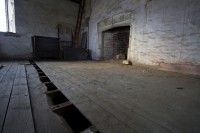 Their power never did get tested. All the construction, refurbishment and witchmarking was for nought as King James didn’t go through with his planned visit to Knole. Thomas Sackvillle, 1st Earl of Dorset, Lord High Treasurer and cousin of Queen Elizabeth I on her mother’s side, died in 1608 before the King’s visit, and his son didn’t have the clout in court to motivate James to keep Knole on the schedule.
Their power never did get tested. All the construction, refurbishment and witchmarking was for nought as King James didn’t go through with his planned visit to Knole. Thomas Sackvillle, 1st Earl of Dorset, Lord High Treasurer and cousin of Queen Elizabeth I on her mother’s side, died in 1608 before the King’s visit, and his son didn’t have the clout in court to motivate James to keep Knole on the schedule.
 Sackville acquired Knole House in 1566. His descendants (including his grandson Richard Sackville, 3rd Earl of Dorset, whom you might recall as Lady Anne Clifford‘s no-good first husband) have lived there ever since. They are still part owners of the estate, sharing it with the National Trust. The Trust is currently in the midst of the largest conservation project in Knole’s history, a multi-year $30 million restoration that is repairing and documenting the structure down to the individual beams. The MOLA team
Sackville acquired Knole House in 1566. His descendants (including his grandson Richard Sackville, 3rd Earl of Dorset, whom you might recall as Lady Anne Clifford‘s no-good first husband) have lived there ever since. They are still part owners of the estate, sharing it with the National Trust. The Trust is currently in the midst of the largest conservation project in Knole’s history, a multi-year $30 million restoration that is repairing and documenting the structure down to the individual beams. The MOLA team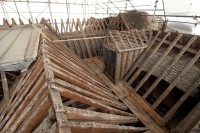 is recording the timber frame structure on behalf of the National Trust to provide essential information necessary to make the proper decisions on the conservation of the estate.
is recording the timber frame structure on behalf of the National Trust to provide essential information necessary to make the proper decisions on the conservation of the estate.
The showrooms are closed during the restoration, but the King’s Room will be open to the public for a special showing on November 20th and 21st. Visitors will have the chance to see the witchmarks before they are covered back up.
Speaking of the Gunpowder Plot, the earliest written report of the arrest and interrogation of Guy Fawkes is coming up for auction at Sotheby’s English Literature, History, Children’s Books and Illustrations sale on December 9th. It’s a letter written by Robert Cecil, 1st Earl of Salisbury, James I’s Secretary of State and spymaster, to Ralph Winwood, the English ambassador to the Hague.
 Dated November 9th, just four days after the plot was discovered, it appears to have been written earlier as it still refers to Fawkes as John Johnson, the alias he had used when posing as co-conspirator Thomas Percy’s servant in order to rent a house next to the House of Lords. Fawkes insisted he was Johnson and had acted entirely on his own for the first two days of interrogations before escalating torture got him to confess his real name on November 7th, and the names of his co-conspirators on November 8th and 9th.
Dated November 9th, just four days after the plot was discovered, it appears to have been written earlier as it still refers to Fawkes as John Johnson, the alias he had used when posing as co-conspirator Thomas Percy’s servant in order to rent a house next to the House of Lords. Fawkes insisted he was Johnson and had acted entirely on his own for the first two days of interrogations before escalating torture got him to confess his real name on November 7th, and the names of his co-conspirators on November 8th and 9th.
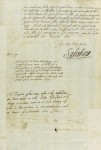 Cecil notes in the letter that despite the threat of the torture, “Johnson” insisted he acted alone and confessed solely to his own crimes from illegal practices of Catholicism to planning the destruction of the entire political hierarchy. They only got him to admit Percy was involved by claiming he’d already been captured and confessed. From the letter:
Cecil notes in the letter that despite the threat of the torture, “Johnson” insisted he acted alone and confessed solely to his own crimes from illegal practices of Catholicism to planning the destruction of the entire political hierarchy. They only got him to admit Percy was involved by claiming he’d already been captured and confessed. From the letter:
[Y]et could no threatening of torture draw from him any other language than this, that he is ready to die, and rather wisheth ten thousand deaths, than willingly to accuse his master or any other ; until by often reiterating examinations, we pretending to him that his master was apprehended, he hath come to plain confession, that his master kept the key of that cellar whilst he was abroad ; had been in it since the powder was laid there, and inclusive confessed him a principal actor in the same.
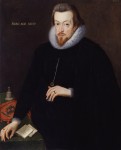 Robert Cecil sent copies of this letter to a number of ambassadors in Europe to enlist them in rumor control and to recommend they deploy a few men-at-arms in countries where the conspirators’ supporters might have been preparing military aid. You can read the full text of the letter to Sir Charles Cornwallis, British ambassador to Spain, in this 1905 book about the Gunpowder Plot. Spoiler: author Philip Sidney is no Robert Cecil fan. Check the footnote).
Robert Cecil sent copies of this letter to a number of ambassadors in Europe to enlist them in rumor control and to recommend they deploy a few men-at-arms in countries where the conspirators’ supporters might have been preparing military aid. You can read the full text of the letter to Sir Charles Cornwallis, British ambassador to Spain, in this 1905 book about the Gunpowder Plot. Spoiler: author Philip Sidney is no Robert Cecil fan. Check the footnote).
Cecil’s letter to Winwood was bought by the Harcourt family in the 19th century. They are now selling it. The presale estimate is £40,000 to £60,000 ($64,000 – $96,000).
The Gunpowder plot was a remarkable business; they had intended to blow up King, Lords, and Commons. Had they succeeded, presumably the mob would have killed damned near every Roman Catholic in two kingdoms.
It was also a silly time to act. James had taken the English throne only in 1603, and had made public his intention to appease his Roman Catholic subjects. Trying to assassinate him was rather impatient behaviour. As it was, the balanced response of the King to events was rather impressive, especially given that his father had been assassinated by being blown up.
And why did the plot founder? Because someone realised that Roman Catholic Lords would be killed too, and so tipped one of them off. Dear God!
All in all, it’s hard not to come to the conclusion that the plotters were exceedingly dim and reckless. Dim, reckless, and brave, I suppose.
O/T: courtesy of the Senchus blog.
http://www.youtube.com/watch?v=AJReFq3g0z0&feature=youtu.be&hootPostID=ca3076054f5ab6556ca2fff656b8bad3
Cool post!
Are there many other records of witch marks in England from around this time?
I find it ironic, since James I was such a big scourge of witches, being the dude who added the one mention of witches to the bible. Were attacks by witches meant to be stopped by the witch marks? But wouldn’t you have to be a witch do do good witch marks?
They remind me a bit of Haitian Vodou veve.
Hmmm. If you know more about all this, please share.
Thanks!